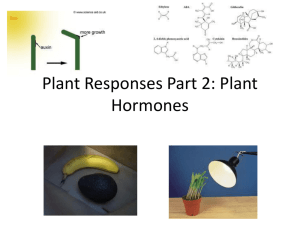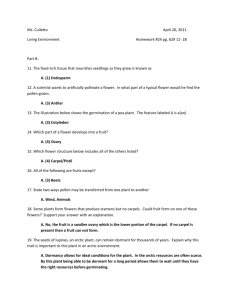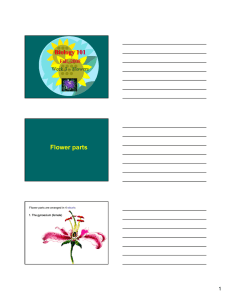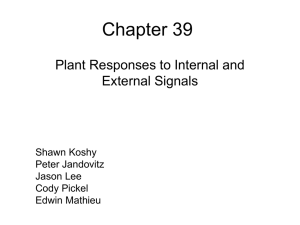Chapters 38-39 Angiosperm Reproduction
advertisement
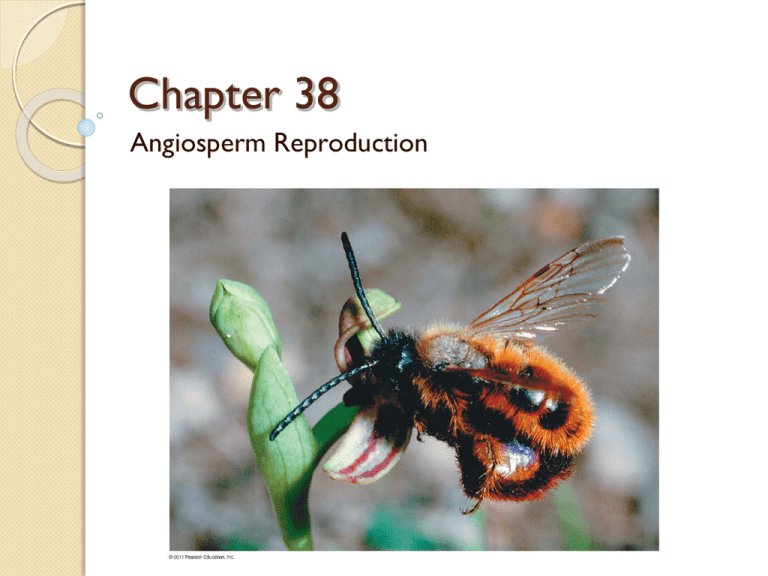
Chapter 38 Angiosperm Reproduction Angiosperms have 3 unique Features: 1. 2. 3. Flowers Fruits Double Fertilization (by 2 sperm) REPRODUCTIVE VARIATIONS Pollination: transfer pollen from anther to stigma Some plants are self-pollinated Cross-pollinated plants: ◦ Self-incompatibility: plant rejects own pollen or closely related plant ◦ Maximize genetic variation Stigma Stigma Anther with pollen Pin flower Thrum flower “Pin” and “thrum” flower types reduce self-fertilization The development of a plant embryo Fruit Egg cell plant embryo Ovules inside ovary seeds Ripe ovary fruit Fruit protects enclosed seed(s) Aids in dispersal by water, wind, or animals Types of Fruit Seeds Mature seed dormancy (resting) ◦ Low metabolic rate ◦ Growth & development suspended ◦ Resumes growth when environmental conditions suitable for germination Germination Seed take up water (imbibition) trigger metabolic changes to begin growth ◦ Root develops shoot emerges leaves expand & turn green (photosynthesis) Very hazardous for plants due to vulnerability Predators, parasites, wind Plant Reproduction Sexual Asexual (Vegetative Reproduction) Flower Seeds Runners, bulbs, grafts, cuttings vegetative (grass), fragmentation, test-tube cloning Genetic diversity Clones More complex & hazardous for seedlings Simpler (no pollinator needed) Advantage in unstable environments Suited for stable environments Asexual reproduction in aspen trees Test-tube cloning of carrots Humans Modify Crops Artificial selection of plants for breeding Plant Biotechnology: ◦ Genetically modified organisms “Golden Rice”: engineered to produce betacarotene (Vit. A) Bt corn: transgenic – expresses Bt (bacteria) gene produces protein toxic to insects ◦ Biofuels – reduce CO2 emissions Biodiesel: vegetable oils Bioethanol: convert cellulose into ethanol Chapter 39 Plant Responses to Internal and External Signals Experiments with Light and the coleoptile Conclusion: Tip of coleoptile senses light some signal was sent from tip to elongating region of coleoptile Excised tip placed on agar block Cells on darker side elongate faster than cells on brighter side AUXIN = chemical messenger that stimulates cell elongation Growth-promoting chemical diffuses into agar block Control (agar block lacking chemical) has no effect Control Agar block with chemical stimulates growth Offset blocks cause curvature Hormones: chemical messengers that coordinate different parts of a multicellular organism Important plant hormones: 1. Auxin – stimulate cell elongation phototropism & gravitropism (high concentrations = herbicide) 2. Cytokinins – cell division (cytokinesis) & differentiation 3. Gibberellins – stem elongation, leaf growth, germination, flowering, fruit development 4. Abscisic Acid – slows growth; closes stomata during H2O stress; promote dormancy 5. Ethylene – promote fruit ripening (positive feedback!); involved in apoptosis (shed leaves, death of annuals) The effects of gibberellin on stem elongation and fruit growth Ethylene Gas: Fruit Ripening Canister of ethylene gas to ripen bananas in shipping container Untreated tomatoes vs. Ethylene treatment Plant Movement 1. Tropisms: growth responses SLOW Phototropism – light (auxin) Gravitropism – gravity (auxin) Thigmotropism – touch 2. Turgor movement: allow plant to make relatively rapid & reversible responses Venus fly trap, mimosa leaves, “sleep” movement Positive gravitropism in roots: the statolith hypothesis. Thigmotropism: rapid turgor movements by Mimosa plant action potentials Plant Responses to Light Plants can detect direction, intensity, & wavelenth of light Phytochromes: light receptors, absorbs mostly red light ◦ Regulate seed germination, shade avoidance Biological Clocks Circadian rhythm: biological clocks Persist w/o environmental cues Frequency = 24 hours Phytochrome system + Biological clock = plant can determine time of year based on amount of light/darkness Photoperiodism: physiological response to the relative length of night & day (i.e. flowering) Short-day plants: flower when nights are long (mums, poinsettia) Long-day plant: flower when nights are short (spinach, iris, veggies) Day-neutral plant: unaffected by photoperiod (tomatoes, rice, dandelions) Night length is a critical factor! How does interrupting the dark period with a brief exposure to light affect flowering? Plant responses to stress 1. Drought (H2O deficit): close stoma release abscisic acid to keep stoma closed Inhibit growth roll leaves reduce SA & transpiration deeper roots 2. Flooding (O2 deprivation): release ethylene root cell death air tubes formed to provide O2 to submerged roots 3. Excess Salt: cell membrane – impede salt uptake produce solutes to ↓ψ - retain H2O 4. Heat: evap. cooling via transpiration heat shock proteins – prevent denaturation 5. Cold: alter lipid composition of membrane (↑unsat. fatty acids, ↑fluidity) increase cytoplasmic solutes antifreeze proteins 6. Herbivores: physical (thorns) chemicals (garlic, mint) recruit predatory animals (parasitoid wasps) 7. Pathogens: 1st line of defense = epidermis 2nd line = pathogen recognition, host-specific
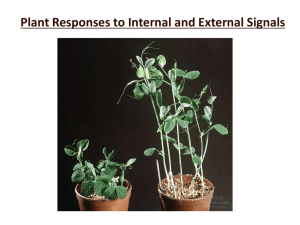
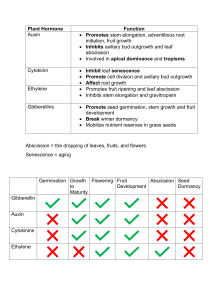
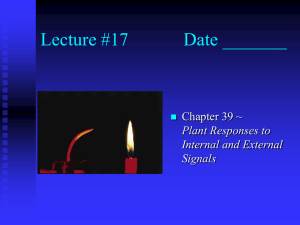
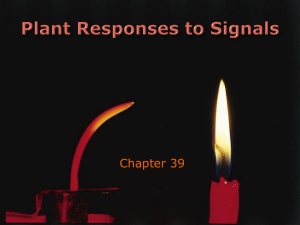

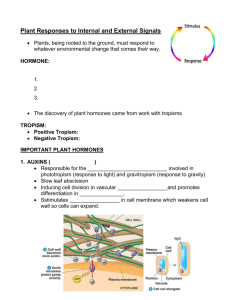
![guide2709.ppt [Compatibility Mode]](http://s3.studylib.net/store/data/008368905_1-88e9b7f8222ebbb87620800faad10ad9-300x300.png)
